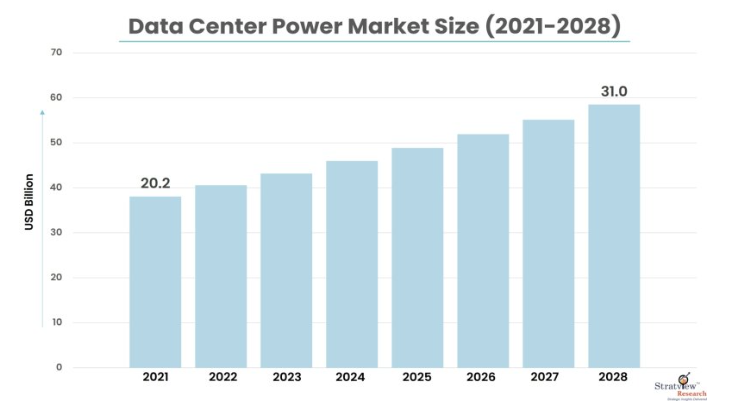With the average cost of downtime amounting to thousands of dollars per minute, uninterrupted data center power is crucial.
Uninterrupted power is vital for any data center to meet the demands of today’s ever-increasing interconnected world. Downtime in data centers costs a fortune. According to a study carried out on 67 data centers with an average area of 232 sq.m, the average cost of downtime was over $7,500 per minute. It wouldn’t be wrong to state that if data centers are vital for today’s soaring computing demands, data center power is nothing short of a fundamental need.
How Much Power Does a Single Data Center Consume?
The power consumption of any data center varies depending on the scale of the facility and the efficiency of the installed equipment. Small data centers that span from 5000-20,000 sq.ft, with 500-2,000 servers, usually consume 1-5 MW of power. Large or hyperscale data centers that span from a large area of 100,000 sq.ft to several million sq.ft, accommodating tens of thousands of servers, consume 20 MW to over 100 MW of power.
Data centers have a huge number of systems and equipment working relentlessly around the clock which consume a lot of power. The power flowing throughout the data centers is usually categorized between the power used by IT equipment including servers, storage, and networks, and the power used by infrastructure resources like cooling and power condition systems.
To avoid potential failures, data center cooling systems are said to consume as much as 50% of any data center’s power.

A breakdown of energy consumption by different components of a data center
There are over 10,900 data center locations worldwide as of December 2023, more than 45% of which are in the US, which houses many of the world's leading data-consuming and producing companies. No doubt, while many of these data centers are highly efficient and can store a huge amount of data, they still consume a lot of power and that remains a significant challenge.
In 2023, data centers across the globe consumed 7.4 GW of power, a 55% increase from the 4.9 Gigawatts in 2022, according to Cushman & Wakefield, a global commercial real estate services firm. The environmental impact of this power consumption is undeniable.
It is estimated that data centers across the world, account for up to 4% of global energy consumption and 1% of global greenhouse emissions. According to the International Energy Agency (IEA), the data centers and data transmission networks accounted for 330 Metric tons of annual CO2 in 2020. This emissions figure may rise in the coming years, driven by the anticipated growth in global data center power requirements.
An estimate from Stratview Research states that the global data center power market is likely to surpass $30 billion by 2028.
Consequently, companies worldwide are making remarkable efforts to hit a PUE ratio of 1.0. Back in 2022, the average PUE ratio was 1.55, according to the Uptime Institute. Today, tech giants like Facebook and Google are close to attaining the desired ratio.

PUE Trends 2007-2022 (Source - Uptime Institute)
Data Center Efficiency Developments
China Telecom Corporation is one of the largest data center operators in the world and has purportedly recorded a PUE ratio of 1.2 in 2022, thanks to the use of AI energy-saving solutions and by retiring low power efficiency and old facilities.
Facebook’s data centers have achieved a PUE ratio of 1.08 in 2022. The company’s Open Compute Project (OCP) servers can accept a higher voltage, and rather than having a large central backup battery, they have smaller backup batteries nearby. Facebook’s ‘vanity-free’ servers have a no-frills design that enhances the data centers’ performance. Altogether, these innovative designs help Facebook data centers save a ton of resources.
Google data centers have achieved 100% renewable energy, and the group is aiming to achieve the goal of 24/7 carbon-free energy (CFE) by 2030.
Amazon also aims to achieve a net-zero carbon emissions target by 2040, by powering its operations, including AWS data centers, with 100% renewable energy by 2025.
Dubai’s Moro Hub, officially announced as the largest solar-powered data center in the world, reduces approximately 13,806 tonnes of CO2 emissions annually. The facility follows the standards for green buildings to achieve net-zero emissions by 2050.
Data Center Power Market Trends
A wide range of physical devices, including toys, tools, and other appliances, around the world are now connected to the internet and create a huge amount of data. The number of connected devices is predicted to cross 207 billion by the end of 2024.
In 2023, the world generated more than 120 zettabytes of data in 2023 and is expected to create around 150 zettabytes in 2024. By 2025, this figure is expected to increase to 180. Moreover, AI has been catapulted into every facet of our lives, and industries are steadily adopting the technology. AI applications generate more data than other types of workloads, and they also need more data storage capacities.
Traditional data centers are designed with 5-10 kW power per rack, while AI data centers require 60 or more kW per rack. This signals a growth in data centers and even more power to run these centers. Nvidia estimates that $1 trillion will be spent over on data center upgrades for AI, with most of the bill being footed by the hyperscalers including Amazon, Microsoft, Google, and Meta.
We can very well imagine that the need for power to run the data centers will continue to grow substantially. By investing in innovative technologies and sustainable practices, data centers can ensure their infrastructure will not only meet this growing demand but also minimizing environmental effects by reducing power consumption.
Authored by - Stratview Research.
Published on- Data Center Knowledge








